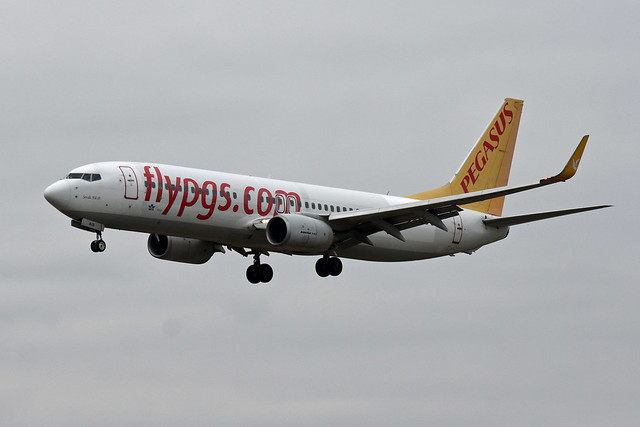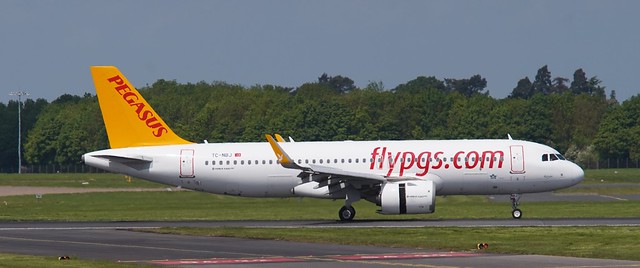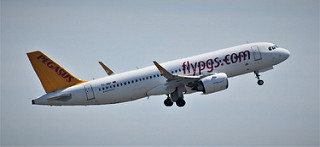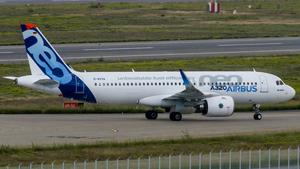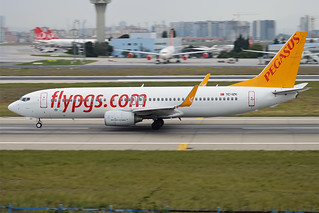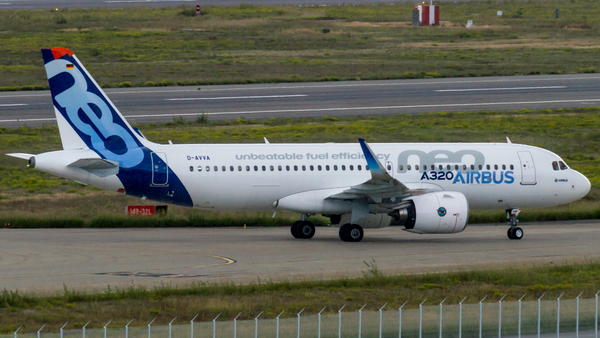Pegasus B738 at Istanbul on Jan 7th 2020, runway excursion on landing
Last Update: September 16, 2021 / 19:36:29 GMT/Zulu time
Incident Facts
Date of incident
Jan 7, 2020
Classification
Incident
Airline
Pegasus Airlines
Flight number
PC-747
Departure
Sharjah, United Arab Emirates
Destination
Istanbul Sabiha Gokcen, Turkey
Aircraft Registration
TC-CCK
Aircraft Type
Boeing 737-800
ICAO Type Designator
B738
Airport ICAO Code
LTFJ
Istanbul's Governor's Office reported the incident occurred due to bad weather. The airport is currently closed, flights are being redirected. The occurrence is being investigated.
The airline reported the aircraft suffered a runway excursion after landing, all occupants disembarked safely. An investigation has begun.
In September 2021 the Turkish Ulasim Emniyeti Inceleme Merkezi (UEIM, Turkish Accident Investigation) created their website and released their first ever final report in Turkish only (Editorial note: to serve the purpose of global prevention of the repeat of causes leading to an occurrence an additional timely release of all occurrence reports in the only world spanning aviation language English would be necessary, a Turkish only release does not achieve this purpose as set by ICAO annex 13 and just forces many aviators to waste much more time and effort each in trying to understand the circumstances leading to the occurrence. Aviators operating internationally are required to read/speak English besides their local language, investigators need to be able to read/write/speak English to communicate with their counterparts all around the globe).
The UEIM concluded the probably causes of the serious incident were:
Human Factors as result of the captain's fault implementation of cross wind landing technique causing a hard touchdown on the runway subsequently steering the aircraft off the runway by applying rudder and ailerons the wrong way with the first officer reacting late.
In addition the report of windshear by previous landing traffic as well as frequent changes of wind direction and intensity are considered contributing factors.
The UEIM listed following main findings:
- pilots were properly licensed and met all regulations, the aircraft met all requirements
- the captain did not apply the proper crosswind landing technique
- a SINK RATE warning occurred twice due to incorrect use of the controls
- the aircraft touched down at +2.605G
- Rudder input was provided to turn the aircraft into the wind instead of counteracting the weathercocking effect
- asymmetric brakes were not used
- the runway excursion is the result of the captain's left rudder application
- the first officer did not intervene
- 24 hours to clear the runway is too long
The UEIM analysed that fatigue was not a factor into the serious incident. Vref had been computed to 142 KIAS, with the wind corrections Vapp was computed at 157 KIAS. According to FDR and CVR data the aircraft performed a stabilized ILS approach to runway 06. At 518 feet AGL the autopilot was disconnected. At 404 feet AGL the airspeed increased to 167 KIAS and reduced to 151 KIAS one second later. Autothrottle gets disconnected at 247 feet AGL, the aircraft is above the glideslope by about half a point, winds at that point 36 knots from 018 degrees, airspeed 169 KIAS. At 197 feet AGL the airspeed is 157 KIAS, winds at 33 knots from 022 degrees.
At 125 feet AGL and 98 feet AGL SINK RATE warnings occurred following large nose down inputs (4 degrees), sink rates above 1000 fpm were recorded between 125 and 57 feet AGL, the aircraft descended 0.6 points below the glideslope and 0.3 points left of the localizer. The aircraft is pitched up by 3 degrees, the airspeed drops to 142 KIAS (15 knots less than required), the aircraft is one dot below the glide and descends at 850 fpm.
The aircraft touched down on the left side of the runway at about 150 KIAS at 681 fpm, engines at 48/44% N1 without being pulled back to idle, the aircraft touched down at +2.605G due to insufficient nose up. The aircraft bounced. With the winds from the left ailerons are applied to the right, but no right rudder is being used to steer the aircraft onto the center line. The aircraft touched down a second time at 6.7 degrees right bank and 3 degrees nose down resulting in +1.6G vertical acceleration. Engines are reduced to idle, full aileron to the right and 5 degrees left rudder are applied, maximum reverse thrust is being applied. Autobrakes engage.
Related NOTAM:
A0101/20 NOTAMN
Q) LTBB/QMRLC/IV/NBO/A /000/999/4054N02919E005
A) LTFJ B) 2001070626 C) 2001070820 EST
E) RWY 06/24 CLSD TO TFC.
Metars:
LTFJ 070850Z 03024G35KT 6000 -SHRA BKN009 BKN030 06/04 Q1015 NOSIG RMK RWY24 01024KT=
LTFJ 070820Z 03025G38KT 6000 -SHRA BKN009 BKN030 06/04 Q1015 NOSIG RMK RWY24 02024KT=
LTFJ 070750Z 03025G37KT 6000 -SHRA BKN009 BKN030 06/05 Q1015 NOSIG RMK RWY24 01025G36KT=
LTFJ 070720Z 03027KT 3900 SHRA BKN009 BKN030 06/05 Q1014 BECMG TL0820 7000 RMK RWY24 02023G35KT=
LTFJ 070650Z 03026G36KT 7000 SHRA BKN009 BKN030 06/05 Q1014 BECMG TL0750 NSW SCT011 BKN025
LTFJ 070620Z 03027G37KT 8000 -SHRA SCT011 BKN030 BKN080 06/04 Q1014 NOSIG
LTFJ 070550Z 03024G36KT 7000 -SHRA SCT011 BKN030 BKN080 06/05 Q1014 NOSIG
LTFJ 070520Z 03028G38KT 7000 -SHRA SCT011 BKN030 BKN080 06/05 Q1013 NOSIG RMK RWY24 01022KT
LTFJ 070450Z 03023G33KT 7000 -SHRA SCT011 BKN030 BKN080 06/05 Q1013 NOSIG RMK RWY24 02023KT
LTFJ 070420Z 03026G37KT 7000 -SHRA SCT011 BKN030 BKN080 06/05 Q1013 NOSIG
LTFJ 070350Z 03026G37KT 8000 -SHRA SCT011 BKN030 BKN080 06/05 Q1012 NOSIG
LTFJ 070320Z 03025G36KT 9999 -SHRA SCT011 BKN030 BKN080 06/05 Q1012 NOSIG
The aircraft off the runway (Photo: Ömer Faruk Meydanal):
Overview:
The aircraft sunk into the soft and wet ground:
Ground tracks:
Map (Graphics: AVH/Google Earth):
Incident Facts
Date of incident
Jan 7, 2020
Classification
Incident
Airline
Pegasus Airlines
Flight number
PC-747
Departure
Sharjah, United Arab Emirates
Destination
Istanbul Sabiha Gokcen, Turkey
Aircraft Registration
TC-CCK
Aircraft Type
Boeing 737-800
ICAO Type Designator
B738
Airport ICAO Code
LTFJ
This article is published under license from Avherald.com. © of text by Avherald.com.
Article source
You can read 2 more free articles without a subscription.
Subscribe now and continue reading without any limits!
Read unlimited articles and receive our daily update briefing. Gain better insights into what is happening in commercial aviation safety.
Send tip
Support AeroInside by sending a small tip amount.
Related articles
Pegasus B738 at Istanbul on Mar 25th 2024, lightning strike
A Pegasus Airlines Boeing 737-800, registration TC-AIS performing flight PC-1281 from Istanbul Sabiha Gokcen (Turkey) to Stockholm (Sweden), was…
Pegasus A20N at Rotterdam on Jun 29th 2023, hydraulic failure
A Pegasus Airbus A320-200N, registration TC-NBJ performing flight PC-5302 from Rotterdam (Netherlands) to Antalya (Turkey), was climbing out of…
Pegasus A20N at Bucharest on Mar 30th 2018, touched down before runway threshold
A Pegasus Airbus A320-200N, registration TC-NBF performing flight PC-361 from Istanbul Sabiha Gokcen (Turkey) to Bucharest Otopeni (Romania), was on…
Pegasus A20N at Basel on Jan 26th 2021, nose gear tilted 90 degrees on landing
A Pegasus Airlines Airbus A320-200N, registration TC-NBH performing flight PC-939 from Istanbul Sabiha Gokcen (Turkey) to Basel/Mulhouse…
Pegasus B738 at Istanbul on Feb 5th 2020, overran runway, impacted wall, broke up
A Pegasus Boeing 737-800, registration TC-IZK performing flight PC-2193 from Izmir to Istanbul Sabiha Gokcen (Turkey) with 177 passengers and 6 crew,…
Newest articles
UPS MD11 at Louisville on Nov 4th 2025, burst into flames on takeoff
A UPS United Parcel Service McDonnell Douglas MD-11, registration N259UP performing flight 5X-2976 from Louisville,KY to Honolulu,HI (USA) with 3…
India A20N near Bhopal on Nov 3rd 2025, cargo smoke indication
An Air India Airbus A320-200N, registration VT-EXO performing flight AI-2487 from Delhi to Bangalore (India) with 172 people on board, was enroute at…
Subscribe today
Are you researching aviation incidents? Get access to AeroInside Insights, unlimited read access and receive the daily newsletter.
Pick your plan and subscribePartner

ELITE Simulation Solutions is a leading global provider of Flight Simulation Training Devices, IFR training software as well as flight controls and related services. Find out more.
SafetyScan Pro provides streamlined access to thousands of aviation accident reports. Tailored for your safety management efforts. Book your demo today
AeroInside Blog
Popular aircraft
Airbus A320Boeing 737-800
Boeing 737-800 MAX
Popular airlines
American AirlinesUnited
Delta
Air Canada
Lufthansa
British Airways


